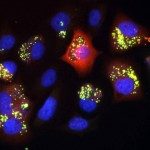About
Our main research projects focus on structural and functional studies of M. tuberculosis DNA gyrase and aim to understand the structural dynamics of DNA recognition by DNA gyrase and the quinolone resistance mechanisms in the treatment of tuberculosis. Current studies address fundamental questions concerning how type II topoisomerases are working, notably by studying the full-length M. tuberculosis DNA gyrase using X-ray crystallography, SAXS and cryo-EM, but also in depth questions concerning specificities of M. tuberculosis DNA gyrase.
Simultaneously, we are using Corynebacterium glutamicum as a surrogate for M. tuberculosis to investigate how known gyrase inhibitors affect bacterial, morphology and physiology. Our goal is to gain a better understanding of how these inhibitors induce bacterial cell death. And ultimately, to identify new gyrase inhibitors through a deep-learning screening process based on bacterial morphology (iScience – Volume 27, Issue 10110967October 18, 2024).



